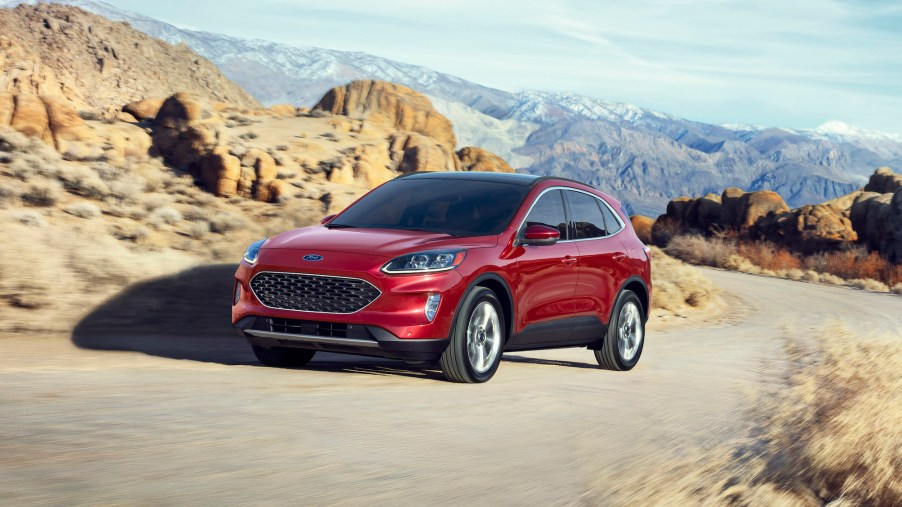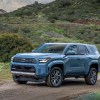
Ford Practically Couldn’t Give Away an Escape in 2020
2020 was a challenging year for new car sales. Mass unemployment robbed many consumers of the ability to buy vehicles, while the pandemic shut down showrooms nationwide. Dealers found innovative ways to sell inventory, and state and local governments scaled back restrictions on auto dealers. But economic uncertainty made many consumers skittish about assuming pricey car loans. So used car sales exploded, and dealers are stuck with a glut of new vehicles.
Luckily for consumers, this means dealers might sell their surplus models at a discount to make way for new inventory. One such vehicle is the 2020 Ford Escape, which the automaker practically couldn’t give away last year.
The new car market meets 2020
iSeeCars, a site that aggregates car inventory data, recently released a report listing estimates of excess inventory on dealer lots in 2020. The site noted that, on average, 22.5 percent of 2020 models remained on dealer lots. However, some brands were far less successful than others at moving their inventory.
Nissan had trouble selling three 2020 models: the Versa, Sentra, and Murano, with 38.7, 43.6, and 48.3 percent unsold. Honda also had difficulty selling three models, the Civic (34.4 percent unsold), CR-V (35.8 percent), and CR-V Hybrid (44.9 percent). Of the top 24 brands on this list, no other entry had more than two models appear.
Ford is the exception. Its 2020 models appear a whopping six times, with the F-150 (40.4 percent unsold), Ranger (51.5 percent), Expedition Max (51.2 percent), Expedition (61 percent), and EcoSport (71.3 percent). And topping the list is the Ford Escape, 90.4 percent of last year’s inventory still for sale.
Reasons to escape the 2020 Ford Escape?
Here’s the thing. The 2020 Ford Escape is far from a bad compact SUV. Sure, it’s not perfect, but its flaws likely don’t fully account for its horrendous sales performance. Its $24,885 starting MSRP is on par with other vehicles in its class. The price may be worth it for buyers looking for a speedy crossover that can hit 60 mph in 8.4 seconds and get 27/33 mpg city/highway. Packing a noisy 1.5-liter turbocharged inline-three engine and eight-speed automatic transmission, the Escape provides drivers with 180 hp and 177 lb-ft of torque. Higher trims come with a 2.0-liter turbo-four producing 250 hp and 275 lb-ft of torque and getting from 0 to 60 mph 1.5 seconds faster.
The Escape is also a safe vehicle, earning good scores from the Insurance Institute for Highway Safety and a 5-star rating from the National Highway Traffic Safety Administration. It comes standard with the Ford Co-Pilot 360 suite of advanced safety features. They include automatic high-beams, emergency automatic braking, blind-spot monitoring, lane-keeping assistance, and cross-traffic-alert. Higher trim levels add driver aids like adaptive cruise control and parking assistance.
Where the Ford Escape falls short is its interior. Car and Driver notes the standard model’s plastic panels don’t match the MSRP. The standard model also comes with a pitifully tiny 4.2-inch touchscreen, smaller than the 8.0-inch screens that usually come standard in SUVs these days. And that system comes only with Bluetooth and an AM/FM radio. Consumers expect more for a nearly $25,000 compact crossover. Of course, you get more with higher trims, but paying up to $5,000 extra for standard features could be why some shoppers opted for other vehicles last year.
Deeper inside the Ford Escape’s dismal sales
During a time of widespread economic uncertainty, the Ford Escape’s price was almost certainly a factor. Beyond that, many consumers lost income in 2020, and a $30,000 vehicle wasn’t in the cards even if it came with all the bells and whistles. Still, this likely isn’t the entire reason behind the Escape’s poor showing.
iSeeCars’ analysis asserts the Escape might’ve been the victim of bad timing. The website notes that production on the 2020 model didn’t begin until early January, much later than many other models and shortly before the national shutdown. Further, the Escape faced competition from the highly anticipated Ford Bronco Sport, a model similar in size and price. According to Detroit Free Press, the Bronco Sport sold over 6,000 units in the first month after its launch in late 2020, while the Escape continued underperforming.
But Ford’s loss could be your gain. With so many Escapes on the market, you may be able to pick one up at a price that better alines with its value. Keep your eyes open, and you might escape with a brand-new Ford.


